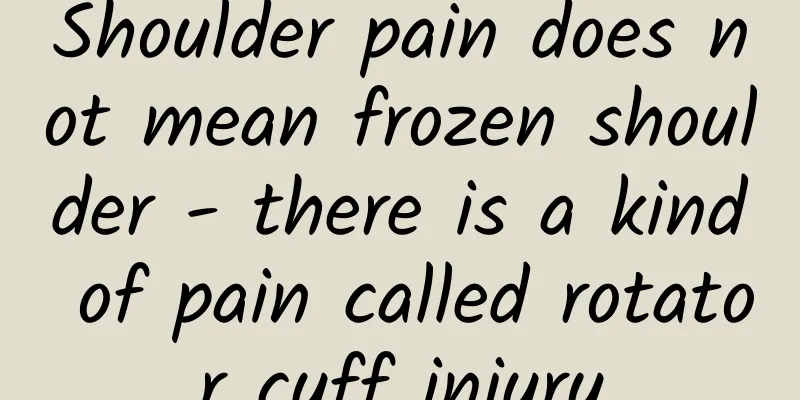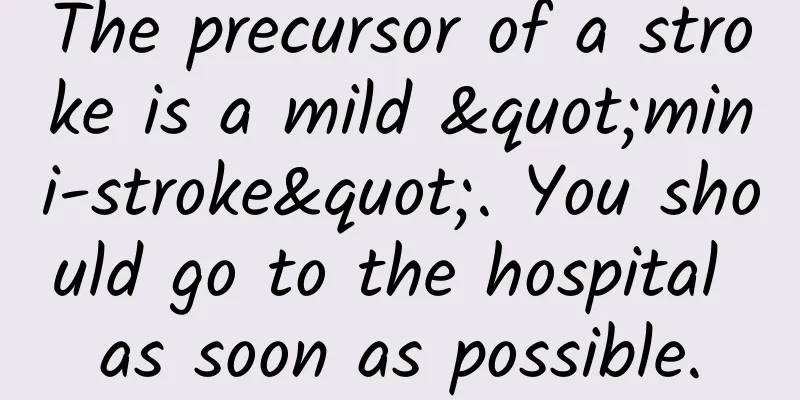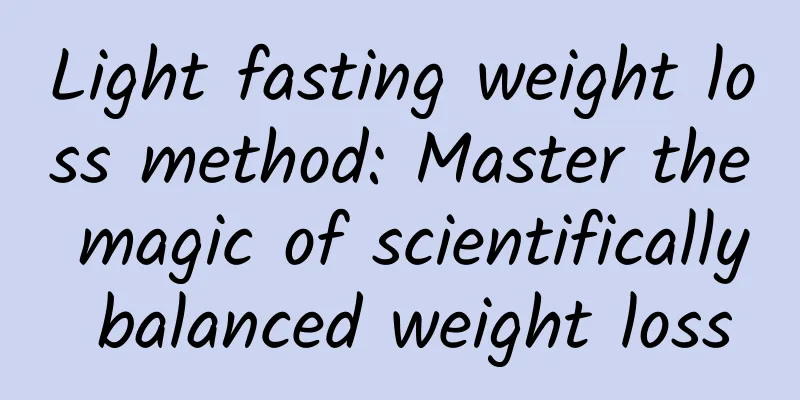Shoulder pain does not mean frozen shoulder - there is a kind of pain called rotator cuff injury

|
Shoulder pain was once attributed to "periarthritis of shoulder", as if all shoulder pain could be summarized by the diagnosis of periarthritis of shoulder, which is like a garbage can. However, with the advancement of medicine, the medical community has a clearer understanding of shoulder pain. What ordinary people think of as periarthritis of shoulder actually only accounts for a small part of shoulder pain, and rotator cuff injury is the culprit of many shoulder pains. Today, Dr. Zhou will talk to you about rotator cuff injuries. 1. What is the rotator cuff? The rotator cuff, as the name suggests, is a sleeve on the shoulder. It is composed of four little brothers (tendons) wrapped around the shoulder. They are the subscapularis tendon located in front of the shoulder joint, the supraspinatus tendon located above, the infraspinatus tendon located above and behind, and the teres minor tendon located behind. These four brothers wrap around the bones of the shoulder joint and play a role in stabilizing the joint. With their help, the shoulder joint can complete actions such as lifting forward, extending backward, lifting upward and outward. 2. What is a rotator cuff injury? What causes it? What are the symptoms? Rotator cuff injury means one or more of the four little brothers mentioned above are damaged or ruptured. There are many reasons for rotator cuff injury, mainly two aspects. First, as we age, the tendons themselves degenerate and lose quality, just like clothes that are old; at this time, frequent and repeated movements or activities of the arms over the head will cause rotator cuff injuries, just like repeatedly tearing old clothes will tear them. This is the case with Aunt Wang in Case 1. The second is a sudden trauma, where the shoulder or elbow hits the ground first. This is the case with Xiao Zhang in Case 2. Of course, there are also cases where the two reasons work together. Rotator cuff injuries often begin with severe pain at night, accompanied by a lack of strength when lifting the shoulder. Only when the rotator cuff injury develops into a major one or a combined peripheral nerve injury will the patient be unable to lift the shoulder completely. As the rotator cuff injury lasts longer, the shoulder pain and weakness make the patient's shoulder less mobile, and gradually the combined shoulder joint adhesions appear, followed by pain, poor mobility, and even stiffness in the shoulder joint. Patients often suffer terribly. 3. How do ordinary people initially distinguish between "rotator cuff injury" and "periarthritis of the shoulder"? A. The most obvious difference is that patients with frozen shoulder have pain in their shoulders and cannot lift or rotate them. Even if someone holds their upper arm or forearm, they still cannot lift or rotate them. (Both active and passive movements are limited, especially external rotation.) Patients with rotator cuff injuries cannot lift their shoulders by themselves because of pain, but can still lift them up with the help of their family members. (Active movement is obviously limited, while passive movement is less limited). B. The second is the high-incidence age. Frozen shoulder (in fact, this name has been eliminated, and "adhesive capsulitis of the shoulder" is more recommended in medicine), also known as "frozen shoulder", is more common in people aged 45-55, and more common in women. In particular, some diabetic patients with poor blood sugar control will have a long course of disease and repeated attacks. In contrast, rotator cuff injuries are more common in elderly patients over 60 years old, and some sports enthusiasts aged 35-45. C. The third difference is the course of the disease. Periarthritis of the shoulder generally tends to heal itself (that is, it will get better slowly over time), and the average duration of onset is about 2 years. Of course, there are many ways to shorten the course of periarthritis of the shoulder, reduce pain, and improve the quality of life. These contents will be explained in detail in the following articles of Zhou Yiseng. The course of rotator cuff injury is very long. Some patients have shoulder pain for 3-5 years, or even more than 10 years. D. The last difference is the treatment plan. Conservative treatment is the first choice for frozen shoulder with mild pain or limited mobility, including range of motion exercises, oral anti-inflammatory and analgesic drugs, joint injections, etc. Only patients with obvious pain and limited mobility, and conservative treatment is not ideal, choose to undergo minimally invasive release surgery under shoulder arthroscopy. Once the rotator cuff injury or rupture is clearly diagnosed, it is generally recommended to undergo shoulder arthroscopy as soon as possible. Because the small holes in the rotator cuff are not repaired, they will develop into large holes over time, and the broken tendon stumps will eventually retract. Severe patients will not be able to repair them even if they want to, and they will spend more money but will not get the desired effect. As the saying goes, "If you don't repair a small hole, you will suffer from a big hole." 4. What methods do doctors use to diagnose "rotator cuff injury"? The doctor will examine your shoulder joint and use some special signs, such as the empty cup test, the lifting test, etc. At the same time, he will also perform a plain MRI scan of your shoulder joint. For patients who have contraindications to MRI, an experienced ultrasound doctor will be scheduled to perform rotator cuff ultrasound to assist in diagnosis. Why can't we just do an X-ray? Because X-rays mainly look at bones, while MRI and B-ultrasound can more clearly see the condition of the body's soft tissues. 5. How to treat rotator cuff injury? A. Generally, for patients with rotator cuff rupture with clear symptoms (night pain, limited joint movement), arthroscopic surgery is recommended as soon as possible. Because "a small hole left unrepaired will cause a big hole to be a problem". If the treatment time of rotator cuff tendon rupture is delayed blindly, the tendon stump may shrink significantly and the tendon may be obviously infiltrated with fat. At that time, even if you beg the doctor to repair it, the doctor will be unable to do anything, and you can only replace the shoulder joint. B. The current treatment for asymptomatic rotator cuff injuries is controversial, and regular follow-up observation and conservative treatment are generally preferred. C. For partial rotator cuff tendon injuries, it is necessary to consider the symptoms of pain and limited mobility, the area and depth of tendon injury to decide whether to use arthroscopic minimally invasive surgery or conservative treatment. For patients who often wake up in pain at night and have obvious limited mobility, arthroscopic minimally invasive treatment combined with functional exercise is now preferred. 6. Is it painful to have a shoulder arthroscopy? What is the general hospitalization process? If the patient does not have too many comorbidities, shoulder surgery is usually performed as a day surgery. Analgesic measures will be used before and after the operation, and there is good anesthesia during the operation, so it is basically painless at Shanghai Changzheng Hospital. Shoulder arthroscopy at Shanghai Changzheng Hospital's Department of Joint Surgery usually requires 2 days of hospitalization. Dr. Zhou's patients can basically complete preoperative examinations and tests in the outpatient clinic. The total hospitalization is 2 days. On the first day, you will be admitted to the hospital on an empty stomach in the morning, complete preoperative preparations, and have shoulder arthroscopy in the afternoon (the operation time is generally about 1 hour). In the evening, the beautiful nurse will monitor your physical condition (what a benefit). On the second day, if there is no obvious anesthetic reaction and pain, you can be discharged and go home. After that, Dr. Zhou will follow up with you in the outpatient clinic and guide your postoperative rehabilitation to help you strengthen your "shoulder" as soon as possible. 7. What is the recovery process after shoulder arthroscopy? How long does it take to return to normal? Doctor Zhou usually divides the patient's recovery into three stages: "tendon growth; restoration of mobility; restoration of strength." The first stage is "tendon growth". During this stage, a shoulder abduction pillow will be worn for 4-6 weeks, mainly to allow the repaired tendon to heal first. During this stage, some small passive activities (pendulum movement, passive external rotation) can be performed, but the arm is basically not actively raised to avoid traction tension affecting tendon healing. The second stage is "restoring the range of motion". In this stage, Doctor Zhou will mainly practice 4 movements to restore the range of motion. The shoulder will feel a little painful during this exercise, and the pain will be significantly reduced after full practice. Doctor Zhou will use some drugs to help the patient practice. This stage usually lasts from 1 to 3 months, depending on each person's preoperative shoulder activity, the frequency and effort of practice, and whether there are complications that aggravate joint adhesion (such as diabetes, etc.). The third stage is "restoring muscle strength". In this stage, patients will be helped to restore muscle strength around the shoulder joint by lifting small dumbbells or mineral water bottles. At this time, the patient's "shoulder" is strong again. Therefore, the rotator cuff will fully recover to normal after surgery. Depending on individual conditions, it will generally recover to normal 4-6 months after surgery. Don't worry too much. Generally, 4 weeks after surgery, most daily movements on the operated shoulder can be completed, and it will not affect daily life. In order to prevent the shoulder from being irreparable, we can overcome this little difficulty. Come on! Let’s learn about “rotator cuff injury” and defeat it scientifically! Reposted from: Zhou Qi, Science and Health Education Center |
<<: Why can't Coke be frozen in the refrigerator (the volume of water will increase and explode)
>>: Popular Science: What is "Sibutramine" that has become a hot topic along with Guo Meimei?
Recommend
What are the dangers of eating aloe vera during pregnancy?
Pregnant women should not eat messy foods often t...
What to do if your legs are swollen when you are six months pregnant
I believe everyone is familiar with the symptom o...
There is a kind of weakness called SMA. Do you know about this rare disease?
The last day of February every year is Internatio...
Is the injection of oxytocin more painful than natural childbirth?
Oxytocin injection is a common drug in medicine. ...
Can I take Astragalus during menstruation?
Many of our friends may not be familiar with the ...
Can learning Go develop intelligence? What is the pattern on the Go board?
Nowadays, parents pay special attention to the co...
What should girls drink to maintain beauty and skin
Many female friends want to make their skin more ...
What does pelvic mass mean?
The pelvic cavity is a woman's internal repro...
Breast distension during early pregnancy and before menstruation
I believe that women are not unfamiliar with the ...
Black chicken soup to replenish blood and qi, three methods are recommended!
Black chicken has always been loved by people bec...
What sanitary napkins did women use in ancient times?
Speaking of sanitary napkins, I believe most of o...
What to do if your period is dirty at 47?
What should I do if my menstruation is not clean ...
Can I eat pomegranate during confinement?
It is now the end of September. In this golden au...
Why does the menstrual flow suddenly decrease?
Many girls will have menstrual problems. Once a p...
What are the diet plans for women to lose weight during the confinement period?
Women pay more attention to maintenance in terms ...









